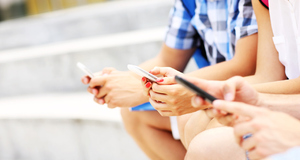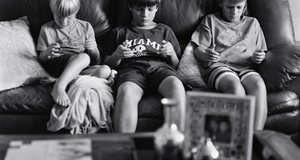|
From Elon Journal of Undergraduate Research in Communications VOL. 5 NO. 1 Cell Phone Use While Walking Across Campus: An Observation and Survey
By Tessa Jones
Elon Journal of Undergraduate Research in Communications
2014, Vol. 5 No. 1 | pg. 2/2 | «
When asked for any other feedback regarding the topic, students provided a number of responses. One student said, “I think that as a society we do rely on instant communication. It has become a blessing and a curse at the same time. Sometimes we do need times to decompress and get away from social media,” while another student simply claimed, “This is depressing.” Two separate respondents mentioned how time abroad has changed their opinion on cell phone use. One student said, "Meals with friends, hanging out with my host family, and other activities with other people are much more enjoyable without everyone looking at their phone. I hope that living abroad without being able to use my phone will make me use my phone less when I return to the States.” Another student responded, “When I was abroad it was such a relief to not be on my phone all the time and when I was on vacation. I wish I could feel like I could have that relief all the time but you are at such a disadvantage to not have your phone because you miss out on things.”
Two additional responses mentioned how students either worry, or have hope for the future in relation to cell phone behaviors. One student said, “The trend of cell phone addiction will only get worse,” while the second claimed, “I think [it’s] the change that is happening, and when our generation has kids, this won’t be an issue anymore.” Another student mentioned one possible impact of excessive cell phone use: “People often forget how to interact face-to-face because we use technology as a crutch to avoid true interaction.” The overall opinion of the majority of student’s surveyed was that they are aware of the behaviors of themselves and their peers. It appears that the addiction is real: young adults are influenced by the negative psychological effects associated with excessive cell phone use and self-gratification.
Observations and a survey of student’s on Elon’s campus showed that Elon is not an exception to the phenomenon that cell phone addiction is affecting many young adults. People are becoming more aware of their own personal habits and behaviors regarding interaction with their devices, and some people believe the obsession surrounding instant and constant communication will diminish by the time Generation Y parents have their own children. Some people claimed that these addictive behaviors and habits arise because they don’t want to be disconnected from their friends and family. They need to have their cell phones so they are able to respond, or reach out to people instantly, and impulsively. Others believe that the use of technology to communicate has decreased our ability to communicate with one another in person. As one survey participant put it, “I think people often forget how to interact face-to-face because we use technology as a crutch to avoid true interaction.”
All it takes to see the truth behind this is observe families and friends at a restaurant. Try to find one group of the targeted individuals who can go the entire duration of their meal without reaching for their cell phone. People also tend to feel much more comfortable behind the screen of a cell phone than in the presence of another person. This is where people lose the ability to face difficult issues and have vocal confrontations with one another. Scientific studies and surveys have shown that there are negative psychological effects related to cell phone addiction. Many young adults need validation that they are pretty or popular, and they use social media, accessed through most cell phones to achieve this self-gratification. Many individuals feel a heightened level of stress and anxiety when they are with their phones, because they are so used to constantly having instant access to communication; others feel free without them because it gives them a chance to disconnect and think their own thoughts without interruption. Overall, it is clear that many members of Generation Y are aware of addictive behaviors they picked up and the accompanying negative consequences.
This author would like to extend a special thanks to Dr. Copeland at Elon University for his constant support and advice. Thanks to his guidance and supervision over the course of the semester, the author has grown as a writer, and is honored to have the article published in the Elon Journal.
Alavi, S. S., Ferdosi, M., Jannatifard, F., Eslami, M., Alaghemandan, H., & Setare, M. (2012). Behavioral addiction versus substance addiction: Correspondence of psychiatric and psychological views. International Journal of Preventive Medicine, 3(4). Retrieved from http://search.proquest.com/docview/1287515141?accountid=10730
Brean, Joseph. “Why This Ontario Family Ditched Their Smartphones so They Could Live for a Year like It’s 1986 - Mullets And all.” National Post News Why This Ontario Family Ditched Their Smartphones so They Could Live for a Year like Its 1986 Mullets Andall Comments. N.p., 9 June 2013. Web. 07 Oct. 2013.
Brian, S. J. (2013, Sep 02). Two days with no phone. Scholastic Action, 37, 4-6. Retrieved from http://search.proquest.com/docview/1432704113?accountid=10730
Carbonell, X., Guardiola, E., Beranuy, M., & Bellés, A. (2009). A bibliometric analysis of the scientific literature on internet, video games, and cell phone addiction*dagger]. Journal of the Medical Library Association, 97(2), 102-7. Retrieved from http://search.proquest.com/docview/203513204?accountid=10730
“The Evolution of Cell Phone Design Between 1983-2009.” Webdesigner Depot RSS. WebDesignerDepot, 22 May 2009. Web. 28 Oct. 2013.
Gardner, Tom. “That 1980’s Show: No Internet, Pink Ghetto Blasters and Mullets, of Course, as Father Bans All Modern Technology for a YEAR to Take Family Back to 1986.” Mail Online. N.p., 6 Sept. 2013. Web. 07 Oct. 2013.
Grzywacz, Bogusia. “Number of Cell Phones in the US.” Number of Cell Phones in the US. N.p., 2002. Web. 28 Oct. 2013.
Mataconis, Doug. “91 percent Of American Adults Own A Cell Phone, Majority Of Them Own A Smartphone.” Outside the Beltway. N.p., 6 June 2013. Web. 28 Oct. 2013.
Morrill, T. B. (2009). Cell phone use and psychosocial development among emerging adults. (Order No. 3379281, Utah State University). ProQuest Dissertations and Theses, 164. Retrieved from http://search.proquest.com/docview/305011871?accountid=10730. (305011871).
Mozes, Alan. “Can Excessive Cellphone Use Become an Addiction?” US News. U.S.News & World Report, 04 Dec. 2012. Web. 7 Oct. 2013.
“U.S. Wireless Quick Facts.” U.S. Wireless Quick Facts. CTIA Advocacy, Dec. 2012. Web. 28 Oct. 2013.
Appendix: Field Observations of students on four campus locations
| |
McEwen |
Moseley |
Belk Library |
Powell |
Total |
Total (%) |
| Holding or texting |
16 |
31 |
23 |
13 |
83 |
43.5 |
| Talking |
3 |
4 |
4 |
2 |
13 |
6.8 |
| Listening |
5 |
9 |
10 |
3 |
27 |
14.1 |
| No phone visible |
26 |
7 |
19 |
16 |
68 |
35.6 |
| Total |
50 |
51 |
56 |
34 |
191 |
100.0 |
- Doug Mataconis, “91 percent Of American Adults Own A Cell Phone, Majority Of Them Own A Smartphone,” Outside the Beltway. Np, 6 June 2013, Web. 28 Oct, 2013.
- Tom Gardner, “That 1980’s Show: No Internet, Pink Ghetto Blasters and Mullets, of Course, as Father Bans All Modern Technology for a YEAR to Take Family Back to 1986,” Mail Online. Np, 6 Sept, 2013. Web, 07 Oct, 2013.
- Joseph Brean, “Why This Ontario Family Ditched Their Smartphones so They Could Live for a Year like It’s 1986 - Mullets And all” National Post News Why This Ontario Family Ditched Their Smartphones so They Could Live for a Year like Its 1986 Mullets Andall Comments, Np, 9 June 2013, Web, 07 Oct, 2013.
- “Number of Cell Phones in the US,” Number of Cell Phones in the US. Np, 2002, Web, 28 Oct, 2013.
- “U.S. Wireless Quick Facts,” U.S. Wireless Quick Facts, CTIA Advocacy, Dec, 2012, Web, 28 Oct, 2013.
- S. S. Alavi, M. Ferdosi, F. Jannatifard, M. Eslami, H. Alaghemandan, & M. Setare, (2012), “Behavioral addiction versus substance addiction: Correspondence of psychiatric and psychological views,” International Journal of Preventive Medicine, 3(4) Retrieved from http://search.proquest.com/docview/1287515141?accountid=10730.
- S. S. Alavi, M. Ferdosi, F. Jannatifard, M. Eslami, H. Alaghemandan, & M. Setare, (2012), “Behavioral addiction versus substance addiction: Correspondence of psychiatric and psychological views,” International Journal of Preventive Medicine, 3(4) Retrieved from http://search.proquest.com/docview/1287515141?accountid=10730.
- Ibid.
- Alan Mozes, “Can Excessive Cellphone Use Become an Addiction?” US News. U.S. News & World Report, 04 Dec, 2012, Web, 7 Oct, 2013.
- Xavier Carbonell, E. Guardiola, M. Beranuy, & A. Bellés, (2009). A bibliometric analysis of the scientific literature on internet, video games, and cell phone addiction, Journal of the Medical Library Association, 97(2), 102-7, Retrieved from http://search.proquest.com/docview/203513204?accountid=10730.
- T. B. Morrill, (2009), Cell phone use and psychosocial development among emerging adults. (Order No. 3379281, Utah State University), ProQuest Dissertations and Theses, 164, Retrieved from http://search.proquest. com/docview/305011871?accountid=10730, (305011871).
- Ibid.
- Ibid.
- Ibid.
- S. J. Brian, (2013, Sep 02), Two days with no phone. Scholastic Action, 37, 4-6, Retrieved from http://search.proquest.com/docview/1432704113?accountid=10730
- Ibid.
Alavi, S. S., Ferdosi, M., Jannatifard, F., Eslami, M., Alaghemandan, H., & Setare, M. (2012). Behavioral addiction versus substance addiction: Correspondence of psychiatric and psychological views. International Journal of Preventive Medicine, 3(4). Retrieved from http://search.proquest.com/docview/1287515141?accountid=10730
Brean, Joseph. “Why This Ontario Family Ditched Their Smartphones so They Could Live for a Year like It’s 1986 - Mullets And all.” National Post News Why This Ontario Family Ditched Their Smartphones so They Could Live for a Year like Its 1986 Mullets Andall Comments. N.p., 9 June 2013. Web. 07 Oct. 2013.
Brian, S. J. (2013, Sep 02). Two days with no phone. Scholastic Action, 37, 4-6. Retrieved from http://search.proquest.com/docview/1432704113?accountid=10730
Carbonell, X., Guardiola, E., Beranuy, M., & Bellés, A. (2009). A bibliometric analysis of the scientific literature on internet, video games, and cell phone addiction*dagger]. Journal of the Medical Library Association, 97(2), 102-7. Retrieved from http://search.proquest.com/docview/203513204?accountid=10730
“The Evolution of Cell Phone Design Between 1983-2009.” Webdesigner Depot RSS. WebDesignerDepot, 22 May 2009. Web. 28 Oct. 2013.
Gardner, Tom. “That 1980’s Show: No Internet, Pink Ghetto Blasters and Mullets, of Course, as Father Bans All Modern Technology for a YEAR to Take Family Back to 1986.” Mail Online. N.p., 6 Sept. 2013. Web. 07 Oct. 2013.
Grzywacz, Bogusia. “Number of Cell Phones in the US.” Number of Cell Phones in the US. N.p., 2002. Web. 28 Oct. 2013.
Mataconis, Doug. “91 percent Of American Adults Own A Cell Phone, Majority Of Them Own A Smartphone.” Outside the Beltway. N.p., 6 June 2013. Web. 28 Oct. 2013.
Morrill, T. B. (2009). Cell phone use and psychosocial development among emerging adults. (Order No. 3379281, Utah State University). ProQuest Dissertations and Theses, 164. Retrieved from http://search.proquest.com/docview/305011871?accountid=10730. (305011871).
Mozes, Alan. “Can Excessive Cellphone Use Become an Addiction?” US News. U.S.News & World Report, 04 Dec. 2012. Web. 7 Oct. 2013.
“U.S. Wireless Quick Facts.” U.S. Wireless Quick Facts. CTIA Advocacy, Dec. 2012. Web. 28 Oct. 2013.
Appendix: Field Observations of students on four campus locations
| |
McEwen |
Moseley |
Belk Library |
Powell |
Total |
Total (%) |
| Holding or texting |
16 |
31 |
23 |
13 |
83 |
43.5 |
| Talking |
3 |
4 |
4 |
2 |
13 |
6.8 |
| Listening |
5 |
9 |
10 |
3 |
27 |
14.1 |
| No phone visible |
26 |
7 |
19 |
16 |
68 |
35.6 |
| Total |
50 |
51 |
56 |
34 |
191 |
100.0 |
Endnotes
- Doug Mataconis, “91 percent Of American Adults Own A Cell Phone, Majority Of Them Own A Smartphone,” Outside the Beltway. Np, 6 June 2013, Web. 28 Oct, 2013.
- Tom Gardner, “That 1980’s Show: No Internet, Pink Ghetto Blasters and Mullets, of Course, as Father Bans All Modern Technology for a YEAR to Take Family Back to 1986,” Mail Online. Np, 6 Sept, 2013. Web, 07 Oct, 2013.
- Joseph Brean, “Why This Ontario Family Ditched Their Smartphones so They Could Live for a Year like It’s 1986 - Mullets And all” National Post News Why This Ontario Family Ditched Their Smartphones so They Could Live for a Year like Its 1986 Mullets Andall Comments, Np, 9 June 2013, Web, 07 Oct, 2013.
- “Number of Cell Phones in the US,” Number of Cell Phones in the US. Np, 2002, Web, 28 Oct, 2013.
- “U.S. Wireless Quick Facts,” U.S. Wireless Quick Facts, CTIA Advocacy, Dec, 2012, Web, 28 Oct, 2013.
- S. S. Alavi, M. Ferdosi, F. Jannatifard, M. Eslami, H. Alaghemandan, & M. Setare, (2012), “Behavioral addiction versus substance addiction: Correspondence of psychiatric and psychological views,” International Journal of Preventive Medicine, 3(4) Retrieved from http://search.proquest.com/docview/1287515141?accountid=10730.
- S. S. Alavi, M. Ferdosi, F. Jannatifard, M. Eslami, H. Alaghemandan, & M. Setare, (2012), “Behavioral addiction versus substance addiction: Correspondence of psychiatric and psychological views,” International Journal of Preventive Medicine, 3(4) Retrieved from http://search.proquest.com/docview/1287515141?accountid=10730.
- Ibid.
- Alan Mozes, “Can Excessive Cellphone Use Become an Addiction?” US News. U.S. News & World Report, 04 Dec, 2012, Web, 7 Oct, 2013.
- Xavier Carbonell, E. Guardiola, M. Beranuy, & A. Bellés, (2009). A bibliometric analysis of the scientific literature on internet, video games, and cell phone addiction, Journal of the Medical Library Association, 97(2), 102-7, Retrieved from http://search.proquest.com/docview/203513204?accountid=10730.
- T. B. Morrill, (2009), Cell phone use and psychosocial development among emerging adults. (Order No. 3379281, Utah State University), ProQuest Dissertations and Theses, 164, Retrieved from http://search.proquest. com/docview/305011871?accountid=10730, (305011871).
- Ibid.
- Ibid.
- Ibid.
- S. J. Brian, (2013, Sep 02), Two days with no phone. Scholastic Action, 37, 4-6, Retrieved from http://search.proquest.com/docview/1432704113?accountid=10730
- Ibid.
Save Citation » (Works with EndNote, ProCite, & Reference Manager)
APA 6th
Jones, T. (2014). "Cell Phone Use While Walking Across Campus: An Observation and Survey." Elon Journal of Undergraduate Research in Communications, 5(1). Retrieved from http://www.inquiriesjournal.com/a?id=975
MLA
Jones, Tessa. "Cell Phone Use While Walking Across Campus: An Observation and Survey." Elon Journal of Undergraduate Research in Communications 5.1 (2014). <http://www.inquiriesjournal.com/a?id=975>
Chicago 16th
Jones, Tessa. 2014. Cell Phone Use While Walking Across Campus: An Observation and Survey. Elon Journal of Undergraduate Research in Communications 5 (1), http://www.inquiriesjournal.com/a?id=975
Harvard
JONES, T. 2014. Cell Phone Use While Walking Across Campus: An Observation and Survey. Elon Journal of Undergraduate Research in Communications [Online], 5. Available: http://www.inquiriesjournal.com/a?id=975
Suggested Reading from Inquiries Journal
Recent technological advancements have had a drastic impact on the way individuals communicate. In this research, previous studies were analyzed, field observations were conducted, and an online survey was administered to determine the level of engagement individuals have with their cell phones, other technologies and with each... MORE»
The observable tendency of a person to repeat the use of drugs, and continue use in spite of possible or real negative consequences, can be partially explained by examining several learning theories and learning with respect to neurological associative strength, and more importantly, the rewards pathways in the brain. There have... MORE»
Pickersgill portrays cellphones in a negative light, making his photo series black and white to not only emphasize his subjects’ faces and body positions, but also to highlight the sharp contrast between traditional photographs taken during particular instances like family dinners or wedding days and Pickersgill’s perception... MORE»
Heroin use and the consequences that come from it are skyrocketing around the United States. From major metropolitan areas to rural towns, millions of people are in the throes of opiate addiction. The traditional response to the illegal use and possession of drugs, including opiates, in the United States is incarceration, but this... MORE»
Latest in Business & Communications
2021, Vol. 13 No. 09
This research lies at the nexus of political communication theory relating to emotional affect and political processing and the burgeoning field of sentiment analysis. News coverage can affect opinion both through the information it provides and... Read Article »
2021, Vol. 13 No. 06
This research study explores factors that present barriers to reporting workplace incidents and contribute to cultures of non-report. The research purpose was to explore human, workplace/organizational, and external factors identified by industrial... Read Article »
2016, Vol. 8 No. 11
In its beta release, Google Glass was positioned as a groundbreaking technology - a glimpse into a future that has long been promised in science fiction. It was met with media fanfare and consumer interest, despite costing more than most PCs on... Read Article »
2016, Vol. 7 No. 1
Predicting the future of the news industry begins with understanding the history of newspapers and the current news delivery landscape. Because the Internet has brought fundamental shifts to news distribution, successful organizations of the future... Read Article »
2016, Vol. 7 No. 1
Instagram allows users to share a snapshot of their lives with a mass audience in a matter of seconds. This capability and power has not gone unnoticed by celebrities, who are highly aware of the impact their social media accounts have on fans and... Read Article »
2016, Vol. 7 No. 1
Since its development, YouTube, the world's third most popular online destination, has transformed from a video-sharing site into a job opportunity for content creators in both new and mainstream media. Based on content analysis, the study examined... Read Article »
2016, Vol. 7 No. 1
Today, more than 15 million Americans practice yoga, making the ancient Indian discipline synonymous with the Western society's culture of wellness. As a way to market themselves, practitioners and instructors of yoga have utilized Instagram &ndash... Read Article »
|




















